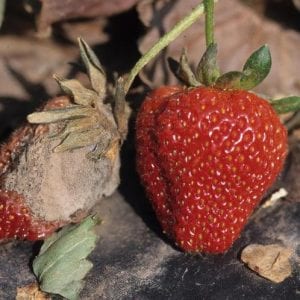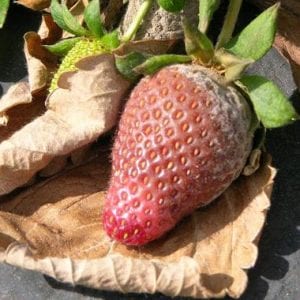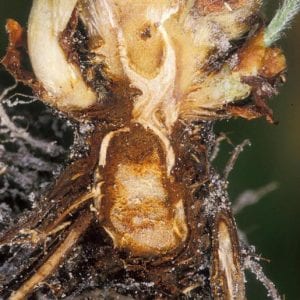Crop Production

Anthracnose and gray mold can create problems for strawberry growers throughout the Southeast. Learn to recognize and manage these diseases.
Most strawberry growers in the Southeast use the annual hill plasticulture system and plant short-day or spring-bearing strawberry varieties. These strawberry plants grow during the warmer parts of the fall and become dormant during the winter months. When weather conditions become favorable in the spring, strawberries begin to bloom and set fruit. From planting to harvest, strawberries have a long growing season, remaining in the field for as long as 8 months. Consequently, there are plenty of opportunities for diseases to develop. Timely, effective disease control is important and can make the difference between a profitable season and a disastrous one.
Botrytis gray mold (Botrytis cinerea) is a serious disease in all strawberry production areas in most years. Gray mold can be a problem in the field and in storage because of the development of a severe rot as the fruit begins to ripen (figures 1 and 2). Gray mold can be managed by following an effective fungicide spray program.
- Figure 1. Symptoms of gray mold (Botrytis cinerea). (Photo credit: Gerald Holmes, California Polytechnic State University at San Luis Obispo, Bugwood.org.)
- Figure 2. Symptoms of gray mold (Botrytis cinerea). (Photo credit: Don Ferrin, Louisiana State University Agricultural Center, Bugwood.org.)
- Figure 3. Anthracnose fruit rot (top) and crown rot (bottom) caused by Colletotrichum spp. (Photo credit: Gerald Holmes, California Polytechnic State University at San Luis Obispo, Bugwood.org).
Anthracnose can create problems in strawberry plantings all over the Southeast. Anthracnose is an economically important disease of strawberries associated with fungi of the genus Colletotrichum. Depending on the species of Colletotrichum, the disease can affect all parts of the plant (figure 3). Anthracnose fruit rot is caused by C. acutatum, while anthracnose crown rot is caused by C. gloeosporioides and C. fragariae. Conditions range from manageable to near crop failure. Growers who follow a regular spray program are the most successful.
Managing Disease in Strawberry
Following an effective spray and sanitation program can help manage disease in strawberries. Following are tips to prevent or minimize damage caused by disease.
- Begin with healthy plants. Buy plants from a reputable nursery. Diseases such as anthracnose will often be present on plants at the nursery. Be sure that your plants are certified disease free.
- Plant resistant cultivars, if possible. A few cultivars, such as ‘Sweet Charlie’ and ‘Bish,’ have demonstrated resistance to anthracnose fruit rot. Regardless of a variety’s resistance to a particular disease, try a small planting before committing significant acreage to a new variety.
- Monitor fields for disease. Scout fields for infected plants especially when conditions are warm and wet. If there are localized areas of infection or “hot spots,” remove and destroy (burn) all infected plants in the area as well as any plants within a 5- to 10-foot radius of the infected area. Harvest all known areas of infection last to minimize spread of the disease. Eliminate or minimize the use of overhead irrigation.
- Early and regular sprays. Begin your spray program early and apply sprays as recommended being careful to follow all pesticide labels. The Southeast Regional Strawberry Integrated Pest Management Guide for Plasticulture Production developed by experts at the Southern Region
Small Fruit Consortium (SRSFC) is available online at https://smallfruits.org/files/2019/06/ StrawberryIPMGuide.pdf. The SRSFC is a multistate alliance of small fruit growers, fruit industry leaders, and service organizations that partner with and serve small fruit growers, agricultural Extension programs, and agricultural research station personnel to develop and strengthen small fruit production in the region. - Use sanitation. Be sure to reduce the population of disease-causing fungi by removing infected leaves and fruit.
- Use crop rotation. Placing strawberries in a rotation with other crops for 2 to 3 years will generally help manage the disease. However, anthracnose of strawberry is not known to remain in the field to infect new strawberry plants.
- Consider using a preplant dip. When anthracnose creates a significant challenge, growers who have a profitable season begin their spray programs early and apply sprays regularly. Another component that growers can add to their disease protection arsenal is the use of dips. Certain fungicides, such as Switch, can be used as dips and have been shown to reduce the incidence of anthracnose and gray mold (Botrytis cinerea) (figure 3). Before planting, submerge plants in the dip for at least 2 minutes. For more information on the use of Switch as a dip to control foliar diseases, see table 1, which is an excerpt from the product label.
Foliar disease in strawberry can be a challenge to manage. Infected plants can harbor anthracnose without showing symptoms. Do not wait until symptoms appear to manage anthracnose. Following the disease management program described in the SRFC strawberry IPM guide will help ensure a successful strawberry season.
Table 1. Use of Switch Fungicide as a Dip to Control Foliar Disease in Strawberry
| Crop | Disease | Product Rate ounce/acre | Remarks |
|---|---|---|---|
| Strawberry and Berry, Low Growing Subgroup 13-07G (except Cranberry (continued) | Root and crown anthracnose at planting (Colletotrichum spp.) | 5-8 oz. per 100 gallons of water | Apply as a preplant dip to strawberry roots and crowns at the rate of 5 to 8 oz. per 100 gallons of water for suppression of root and crown rot caused by anthracnose. Wash transplants to remove excess soil prior to dipping. Completely immerse planting stock in dip solution. Dip or expose plants for a minimum of 2 minutes or a maximum of 5 minutes. Completely drain the transplants after dip. DO NOT reuse solution. Dispose of dip solution according to local regulations. |
| Strawberry | |||
| And cultivars and/or hybrids of these | Plant treated plants as quickly as possible. For continued anthracnose control, follow with foliar applications beginning 2-3 weeks after transplanting. |
 Edgar Vinson, Assistant Extension Professor/Assistant Research Professor, Horticulture, and Edward Sikora, Extension Specialist, Professor, Entomology and Plant Pathology, both with Auburn University
Edgar Vinson, Assistant Extension Professor/Assistant Research Professor, Horticulture, and Edward Sikora, Extension Specialist, Professor, Entomology and Plant Pathology, both with Auburn University
Reviewed February 2023, Early Management of Gray Mold & Anthracnose, ANR-2603




